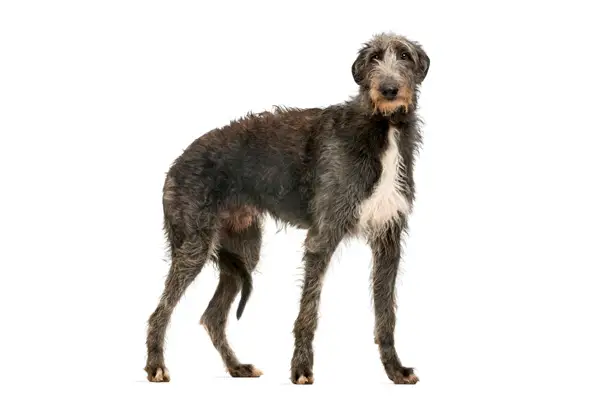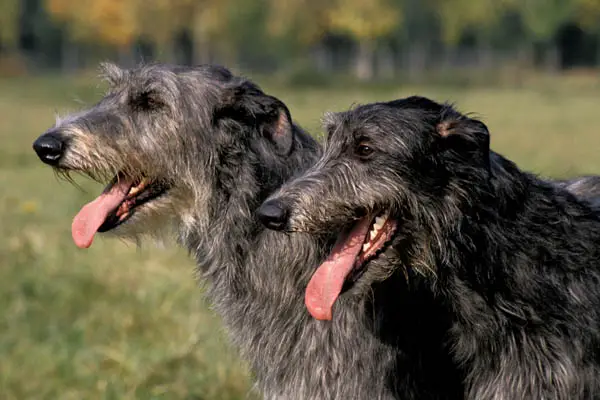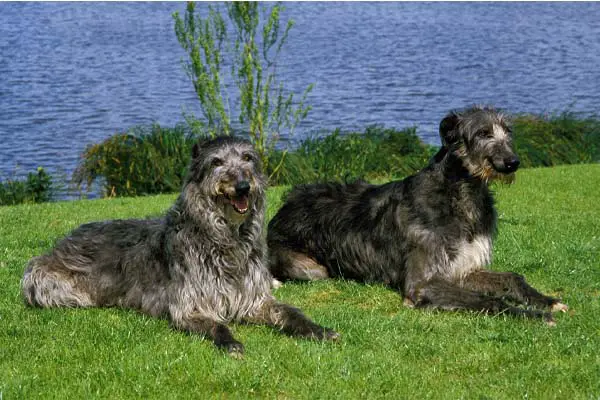Scottish Deerhounds are majestic dogs from Scotland that stand at a height of 32 inches. They are often described as having large greyhounds, but only with a wiry coat. Also, the Scottish Deerhound has more refined features that make them more elegant than traditional greyhound breeds.
Scottish Deerhounds are gentle dogs with a great royal history. However, despite being kind and gentle for inexperienced owners, they are not apartment-living dogs. They need to run, so they need to have a large, securely fenced space.
They’re also best living in one-dog households, with no small animals that may trigger their strong prey drive. These are giant dogs built for speed; if you think you can cope with that, this dog is a great companion for life.

Scottish Deerhound Statistics
| Dog Breed Group | Hound |
| Breed Size | Large to Giant |
| Height | 30-32 inches (male); 28 inches & up (female) |
| Weight | 85-110 pounds (male); 75-95 pounds (female) |
| Lifespan | 8-11 years |
Scottish Deerhound Ratings
| Energy level | |
| Exercise needs | |
| Requires attention | |
| Playfulness | |
| Trainability | |
| Shedding | |
| Grooming | |
| Friendly with family | |
| Friendly with kids | |
| Friendly with strangers | |
| Friendly with other dogs | |
| Prey Drive |
Scottish Deerhound History
Scottish Deerhounds have a very long history that their true origin is not known. They’ve been called by many names: Irish wolfhounds, Scottish greyhounds, rough greyhounds, and Highland deerhounds.
Back in the 16th century, these dogs were used for hunting and bringing down deer. They were highly regarded dogs for their courage and gentleness that only noblemen could own one. In fact, no one beneath the earl’s rank can buy a deerhound, thus claiming the title as the Royal Dog of Scotland.
Due to the restricted ownership, the Scottish Deerhound almost came to the brink of extinction, especially in 1745, when Scotland’s system nearly collapsed. By 1769, the breed was in danger of being lost in history.
That was until the 1820s when Archibald and Duncan McNeill started their breeding efforts to restore these majestic dogs. Soon after, the breed was brought to America and was registered in the American Kennel Club in 1886.
During World War I, the breed’s numbers decreased again in Scotland and England and were considered rare.
Even today, the dogs are considered uncommon, with only a few starting to appreciate how great these dogs are to have. Today, they rank 158th as the most popular dog breed in the US.

Scottish Deerhound Temperament
Scottish Deerhounds are gentle, dignified, and polite dogs. They are known to be quiet and laid-back dogs who love to spend time on the couch. They can be considered couch potatoes, watching the world go by in the comforts of his seat until he finds something interesting.
These are runners, and unlike other dog breeds that would prefer fetching balls, tug of wars, or daily walks, they love to run. It’s essential to have a securely fenced yard if you want to own one. Also, they are best in households that don’t have small pets that they can chase.
Scottish Deerhounds are loyal and devoted dogs to their family. They are one-family dogs, so though they are friendly with strangers, they are not very affectionate.
They are courageous dogs in the face of danger, but in most situations, they are not aggressive. Their laid-back personalities make them not the best guard dogs or watchdogs to get. But their large size might be enough to intimidate any thief that might want to come to your house.
They are also known to be good with other dogs, well, given that they are socialized at an early age. Keep close supervision if you have toddlers as the dog’s size may injure them.
These dogs can be mildly stubborn and independent; thus, training may come a bit challenging. Just remember to make everything exciting and cheerful, and he’ll be happy to respond. Positive reinforcements should always work in the form of praises and food rewards.
Scottish Deerhound Care Requirements
- Nutrition: Scottish Deerhounds don’t have any special dietary requirements. However, it is essential that you only feed them with high-quality and well-balanced meals daily. It should consist of a balance of proteins, fats, and carbohydrates to support healthy growth. It’s crucial that you only buy high-quality ingredients for your dog to get the best nutrition possible. Even dog food and dog treats should be of premium quality. Make sure to check the label and ensure that there are no fillers, additives, and by-products added. Another thing that you should also watch is the number of calories you feed your dog. Not because these are large dog breeds, you should feed them a lot. The amount you feed them should depend on their age, metabolism, and activity level. It’s still best to ask your vet for the best feeding requirements specific for your dog. Take note of any ingredients they might be allergic to and stay away from those.
- Grooming: Scottish Deerhounds have harsh, wiry coats that shed seasonally. The coats are known to be very easy to care for, which will involve an all-over brushing or combing at least once a week. Baths can be given occasionally, depending on your dog’s needs. If he gets too smelly or dirty even after just two weeks, don’t hesitate to bath him. Ears should be cleaned regularly to prevent ear infection. Nails should be checked and trimmed at least every two weeks, depending on if it gets too long already. Long nails will give pain and discomfort to your dog, so ensure that it stays short.
- Exercise: Scottish Deerhounds need their regular exercise. They were bred to run, after all, so you must let him do so. They must always have companions, playmates, and a securely fenced area as they grow up. These dogs, regardless if their puppies or adults, need to be exercised freely. Meaning, they want to run around on their own. Forced exercises like making him accompany you for a run or bike, will not be an enjoyable activity.
- Health: Scottish Deerhounds are generally healthy dogs, but like any other dog breeds, they are prone to getting certain health conditions. As dog owners, it’s essential to be aware of what they are so you’ll know what to do if your dog acquires it. As most of these diseases are hereditary, it’s best to meet at least one of your dog’s parents. This way, you’ll know what health conditions your dogs might acquire. Here are the diseases common to the Scottish Deerhounds:
-
- Anesthesia Sensitivity
- Dilated Cardiomyopathy
- Cystinuria
- Osteosarcoma
- Factor VII Deficiency
- Gastric Torsion
- Allergies
- Hypothyroidism
-
- Lifespan: The life expectancy of Scottish Deerhounds is 8-11 years.

Famous Scottish Deerhounds
- Foxcliffe Hickory Wind: Won Best in Show in the 2011 Westminster Kennel Club Dog Show
- Bonnie Robin: The first Scottish Deerhound registered by the American Kennel Club
- Maida: Sir Walter Scott’s Scottish Deerhound
Fun Facts About Scottish Deerhounds
- Scottish Deerhounds are ancient dogs that originated from Scotland.
- They are closely related to Irish Wolfhounds.
- They’ve been called by many names: Irish wolfhounds, Scottish greyhounds, rough greyhounds, and Highland deerhounds.
- Queen Victoria loved the breed that she even made them official members of the canine aristocracy.
- This breed is known as the Royal Dog of Scotland; no one under the earl’s rank can own one.
- They come in various colors: grey, brindle, red, black, pure white, or fawn.
- They came close to extinction in the year 1745.
- Recognized by the American Kennel Club in 1886.
Check Out Other Hound Dog Breeds:
Afghan Hound, American English Coonhounds, American Foxhound, Basenjis, Basset Hound, Beagle, Black and Tan Coonhound, Bloodhound, Bluetick Coonhound, Borzois, Cirnechi dell’Etna, Dachshund, English Foxhound, Grand Basset Griffon Vendeens, Greyhound, Harrier, Ibizan Hound, Icelandic Sheepdogs, Irish Wolfhound, Norwegian Elkhound, Otterhound, Petit Basset Griffon Vendéen, Pharaoh Hounds, Plotts, Portuguese Podengo, Redbone Coonhound, Rhodesian Ridgeback, Salukis, Sloughis, Treeing Walker Coonhound, Whippet
